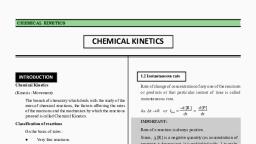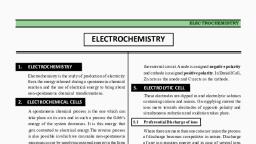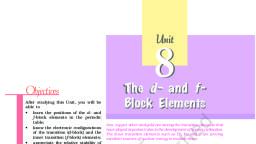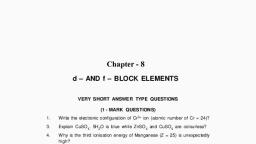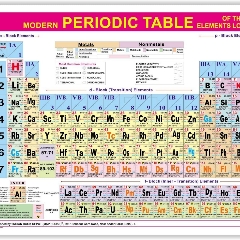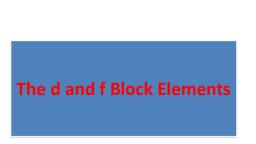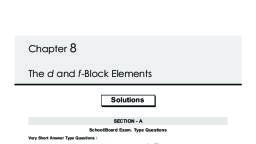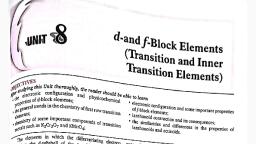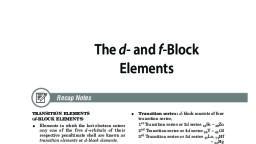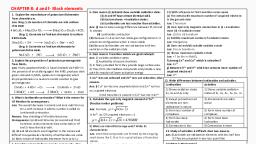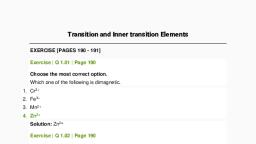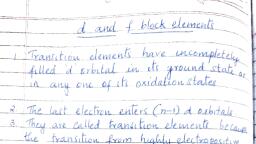Page 1 :
d & f BLOCK ELEMENTS, , d & f BLOCK ELEMENTS, , 1.2 Electronic configuration, , 1. INTRODUCTION, (1), , 1., , In d-block elements with increase in atomic number, the dorbitals of penultimate shell i.e. (n-1) d are gradually filled, by electrons. The general electronic configuration of dblock element is,, (n-11) d1-10, ns0-2., Depending upon the d-orbitals of which penultimate shell, i.e. n = 4, 5, 6, 7 are filled, four rows (called series) os ten, elements each obtained. They correspond to 3d, 4d, 5d and, 6d subshells., Energy of ‘(n–1)d’ subshell is slightly greater than ‘ns’, subshell, hence orbital is filled first then (n – 1) d orbitals., The general electronic configuration of d-block/d-series, elements be shown as follows :, First (3d) Transition Series (Sc–Zn), , 2., , Second (4d) Transition Series (Y-Cd), , 3., , Third (5d) Transition Series (La–Hg), , 4., , Fourth (6d) Transition Series, , 1.1 Definition, “The elements in which the last differentiating electron enters, into the d-orbitals of the penultimate shell i.e., (n–1) d where n is the last shell are called d-block elements”., A transition element may also be defined as the element, which partially filled d-orbital in their ground state or most, stable oxidation state., Cu (Z = 29) = 1s2 2s2 2p6 3s2 3p6 3d10 4s1, Cu2+ = 1s2 2s2 2p6 3s2 3p6 3d9, (Cupric ion), , The properties of these elements are intermediate between, the properties of s-block and p-block elements., These elements represent a change or transition in, properties from more electropositive elements (s-block) to, less electropositive elements (p-block). Therefore these, elements are called transition elements., Position in the periodic table, The position of d-block element has been shown in periodic, table as follows :, , (1), , (2), , d-block elements lie in between ‘s’ and ‘p’ block elements,, i.e. these elements are located in the middle of the periodic, table., d-block elements are present in,, 4th period (21Sc to 30Zn, 10 elements) o�1st Transition series., 5th period (39Y to 48Cd, 10 elements) o�2nd Transition series., 6th period (51La, 72Hf to 80Hg, 10 elements) o�3rd Transition, series., 7th period (89Ac, 104Rf to 112Uub, 10 elements) o�4th Transition, series., , (2), , (3), (4), , Exceptional configuration of Cr and Cu. The exceptions, observed in the first series are in case of electronic, configurations of chromium (Z = 24) and copper (Z = 29). It, may be noted that unlike other elements, chromium and, copper have a single electron in the 4s-orbital. This is due, to the gain of additonal stability by the atom by either having, half-filled configuration (i.e., containing 5 electrons in the, d-sublevel) or completely filled configuration, (i.e.,, containing 10 electrons in the d-sublevel). The 3d-level in, case of chromium gets excatly half-filled with configuration, 3d5 4s1 and that in case of copper, it gets completely filled, with configuration 3d10 4s1. This can be explained on the, basis of exchange energy
Page 2 :
d & f BLOCK ELEMENTS, Thus, the electronic configuration of chromium (Z = 24), and copper (Z = 29) are 1s2 2s2 2p6 3s2 3p6 3d5 4s1 and 1s2 2s2, 2p6 3s6 3p6 3d10 4s1 respectively., , 1.5 Metallic character, Except for mercury which is a liquid, all the transition, elements have typical metallic structure. They exhibit all, the characteristics of metals. ductile, have high melting and, boiling points, high thermal and electrical conductivity and, high tensile strength., Transition elements have relatively low ionization energies, and have one or two electrons in their outermost energy level, (ns1 or ns2). As a result, metallic bonds are formed. Hence, they, behave as metals. Greater the number of unpaired d electrons,, stronger is the bonding due to the overlapping of unpaired, electrons between different metal atoms., , 1.3 Properties, 1., , Atomic Raddii, , (i), , The atomic radii of the transition metals lie in-between those, of s- and p-block elements., , (ii), , Generally the atomic radii of d-block elements in a series, decreas with increase in atomic number but the decrease in, atomic size is small after midway., , Explanation, The atomic radius decreases with the increase in atomic, number as the nuclear charge increases whereas the, shielding effect of d-electron is small. After midway, as the, electrons enter the last but one (penultimate) shell, the added, d-electron shields (screens) the outermost electron. Hence,, with the increase in the d-electrons, screening effect, increases. This counterbalances the increased nuclear, charge due to increase in atomic number. As a result, the, atomic radii remain practically same after chromium. For, example in Fe, the two opposing tendencies almost, counterbalance and there is no change in the size from Mn, to Fe., (iii) At the end of the period, there is a slight increase in the, atomic radii., Explanation, Near the end of series, the increased electron-electron, repulsions between added electrons in the same orbitals, are greater than the attractive forces due to the increased, nuclear charge. This results in the expansion of the electron, cloud and thus the atomic radius increases., (iv) The atomic radii increase down the group. This means that, the atomic radii of second series are larger than those of, first transition series. But the atomic radii of the second, and third transition series are almost the same., The atomic radii of the elements of the second and third, transition metals are nearly same due to lanthanide, contraction (or also called lanthanoid contraction), discussed later., 1.4 Ionic radii, , 1.6 Melting Point, Transition metals have high melting points which is due to, their strong metallic bond. The metallic bond. The metalic, bonding depends upon the number of unpaired e–. The, melting point first increases (Sc-Cr), reaches a maximum value, (Cr) and then decreases (Fe-Zn), * Tungsten (W) has the highest melting point., * Mercury (Hg) has the lowest melting point., * Mn has the lowest melting point in 3d series typicl, transition elements., 1.7 Ionisation energies or Ionisation enthalpies, (i), , The first ionisation enthalpies of d-block elements lie between, s-block and p-block elements. They are higher than those of sblock elements and are lesser than those of p-block elements., The ionisation enthalpy gradually increases with increase in, atomic number along a given transition series though some, irregularities are observed, Explanation, (i) The increasing ionization enthalpies are due to increased, nuclear charge with increase in atomic number which reduces, the size of the atom making the removal of outer electron, difficult., (ii) In a given series, the difference in the ionisation enthalpies, between any two successive d-block elements is very much, less than the difference in case of successive s-block or pblock elements., Explanation, The addition of d electrons in last but one [(n — 1) or, penultimate] shell with increase in atomic number provides, a screening effect and thus shields the outer s electrons, from inward nuclear pull. Thus, the effects of increased, nuclear charge and addition of d electrons tend to oppose, each other., , (i), , The trend followed by the ionic radii is the same as that, followed by atomic radii., , (iii) The first ionization enthalpy of Zn, Cd and Hg are, however,, very high because of the fully filled (n-1) d 10 ns 2, configuration., , (ii), , Ionic radii of transition metals are different in different, oxidation states., , (iv) Although second and third ionization enthalpies also, in, general, increase along a period, but the magnitude of, increase for the successive elements is much higher., , (iii) The ionic radii of the transition metals are smaller than those, of the representative elements belonging to the same period.
Page 3 :
d & f BLOCK ELEMENTS, (v), , In ‘3d’ series all element contain 2 electrons in ‘4s’ and hence, they all give a common minimum oxidation state of +2., (Except ‘Cr’ and ‘Cu’ where minimum oxidation state is +1.], The maximum oxidation state is given by Mn i.e. Mn+7 in, which two electrons are removed from 4s and five unpaired, electrons are removed from 3d orbitals., , The high values of 3rd ionization enthalpies for Cu, Ni and, Zn explain why they show a maximum oxidation state of +2., , (vi) The first ionisation enthalpies of 5d elements are higher as, compared to those of 3d and 4d elements. This is because, the weak shielding of nucleus by 4f electrons in 5d elements, results in greater effective nuclear charge acting on the, outer valence electrons., , (4), , The highest oxidation state is shown by Ruthenium (Ru), and Osmium (Os) i.e. +8., , (5), , Across the period oxidation state increases and it is maximum, at the centre and than decreases even if atomic number, increases. The element which shows highest oxidation state, occur in the middle or near the middle of the series and than, decreases., , (6), , Transition metals also show zero oxidation states in metal, carbonyl complex. (Nickel tetracarbonyl)., , 1.8. Oxidation state, “The net numerical charge assigned to an atom of an element, in its combined state is known as its Oxidation state or, Oxidation number”., (1), , With the exception of few elements, most of the d-block, elements show more than one oxidation state i.e. they show, variable oxidation states. The elements show variable, oxidation state because of following reasons:, , (i), , ‘(n-1) d’ and ‘ns’ orbitals in the atoms of d-block elements, have almost same energies and therefore electron can be, removed from ‘(n-1)d’ orbitals as easily as ‘s’ orbitals, electrons., , (ii), , After removing ‘s’ electrons, the remainder is called Kernel, of the metal cations. In d-block elements, the kernel is, unstable and therefore it loses one or more electrons from, (n – 1)d electrons. This results in formation of cations with, different oxidation states., , (2), (3), , Example : Ni in Ni (CO)4 has zero oxidation state., (7), , The bonding in the compounds of lower oxidation state, (+2, +3) is mostly ionic and the bonding in the compounds, of higher oxidation state is mostly covalent., , (8), , The relative stabilities of some oxidation states can be, explained on the basis of rule extra stability, according to, which d0, d5 and d10 are stable configurations., For example, the stability order of some ions is as follows:, Ti4+ (3d0, 4s0) > Ti3 (3d1, 4s0), Mn2+ (3d5, 4s0) > Mn3+ (3d4, 4s0), , All transition elements show variable oxidation state except, last element in each series., Minimum oxidation state = Total number of electrons in 4s, lost. Maximum oxidation state = (Total number of electrons, in 4s + number of unpaired electrons in 3d lost)., , Fe3+, (3d5, 4s0) > Fe2+ (3d6, 4s0), (9), , Cu+2 is more stable than Cu+1 even when Cu+1 is 3d10 while, Cu+2 is 3d due to high heat of hydration., , Variable oxidation states shown by 3d-series of d-block elements., , Oxidation States, ELECTRONIC, CONFIGURATION, , Sc, d1s2, , Ti, , V, , Cr, , Mn, , Fe, , Co, , Ni, , Cu, , Zn, , d 2s 2, , d 3s 2, , d4s 2, , d5s 2, , d 6s2, , d 7s 2, , d8s 2, , d9s 2, , d 10 s 2, , d5s 1, , d 10 s 1, , +1, , +1, , +2, , +2, , +2, , +2, , +2, , +2, , +2, , +2, , +2, , +3, , +3, , +3, , +3, , +3, , +3, , +3, , +3, , +3, , +4, , +4, , +4, , +4, , +4, , +4, , +4, , +5, , +5, , +5, , +5, , +5, , +6, , +6, , +6, , +7, , +2
Page 4 :
d & f BLOCK ELEMENTS, 1.9 Standard electrode potentials (E o) and chemical, reactivity, Thermodynamic stability of the compounds of transition, elements can be evaluated in terms of the magnitude of, ionisation enthalpies of the metals — smaller the ionisation, enthalpy of the metal, stabler is its compound., In solution, the stability of the compounds depends upon, electrode potentials rather than ionization enthalpies., Electrode potential values depend upon factors such as, enthalpy of sublimation (or atomisation) of the metal, the, ionisation enthalpy and the hydration enthalpy, i.e.,, ' sub H, o M g , ('subH is enthalpy of sublimation/, M s , , atomisation), ' iH, o M � g � e� , ('i H is ionisation enthalpy), M s , ' hyd H, , M � g � aq o M � aq , (' hyd H is enthalpy of, , hydration), The total energy, ' T H, for the process involving, sublimation, ionisation and hydration simultaneously, i.e.,, , (iv) The values of Eo for Mn, Ni and Zn are more negative than, expected from the generall trend. This is due to greater, stability of half-filled d-subshell (d5) in Mn2+, and completely, filled d-subshell (d10) in Zn2+. The exceptional behaviour of, Ni towards Eo value from the regular trend is due to its high, negative enthalpy of hydration., Trends in the M3+/M2+ Standard Electrode Potentials, (i), , A very low value for Eo (Sc3+/Sc2+) reflects the stability of, Sc3+ ion which has a noble gas configuration., , (ii), , The highest value for Zn is on account of very high stability, of Zn2+ ion with d10 configuration. It is difficult to remove, an electron from it to change it into +3 state., , (iii) The comparatively high value of Eo (Mn3+/Mn2+) shows, that Mn2+ is very stable which is on account of stable d5, configuration of Mn2+., (iv) The comparatively low value of Eo (Fe3+/Fe2+) is on account, of extra stability of Fe3+ (d5), i.e., low third ionization enthalpy, of Fe., (v), , The comparatively low value for V is on account of the, stability of V2+ ion due to its half-filled t 32g configuration, , o M � aq � e � , will be the sum, for the process, M s , , (discussed in unit 9)., , of the three types of enthalpies, i.e.,, , Chemical Reactivity and Eo Values. The transition metals, vary very widely in their chemical reactivity. Some of them, are highly electropositive and dissolve in mineral acids, whereas a few of them are ‘noble’, i.e., they do not react with, simple acids. Some results of chemical reactivity of transition, metals as related to their Eo values are given below :, , 'TH, , ' sub H � ' i H � ' hyd H., , Thus, 'T H, is the total enthalpy change when solid meal,, M is brought in the aqueous medium in the form of, monovalent ion, M+ (aq)., , Trends in the M2+/M Standard Electrode Potentials, (i), , There is no regular trend in the Eo (M2+/M) values. This is, because their ionization enthalpies (I1 + IE2) and sublimation, enthalpies do not show any regular trend., , (ii), , The general trend towards less negative Eo values along, the series is due to the general increase in the sum of first, and second ionization enthalpies., , (iii) Copper shows a unique behaviour in the series as it is the, only metal having positive value for Eo. This explains why, is does not liberate H2 gas from acids. It reacts only with, the oxidizing acids (HNO3 and H2SO4) which are reduced., The reason for positive Eo value for copper is that the sum, of enthalpies of sublimation and ionization is not balanced, by hydration enthalpy., , (i), , The metals of the first transition series (except copper) are, relatively more reactive than the othr series. Thus, they are, oxidized by H+ ions though the actual rate is slow, e.g., Ti, and V are passive to dilute non-oxidizing acids at room, temperature., , (ii), , As already explained, less negative Eo values for M2+/M, along the series indicate a decreasing tendency to form, divalent cations., , (iii) More negative Eo values than expected for Mn, Ni and Zn, show greater stability for Mn2+, Ni2+ and Zn2+., (iv) Eo values for the redox couple M3+/M2+ indicate that Mn3+, and Co3+ ions ar the strongest oxidizing agents in aqueous, solution whereas Ti2+, V2+ and Cr2+ are strongest reducing, agents and can liberate hydrogen from a dilute acid, e.g., 2, o 2 Cr3+ (aq) + H2 (g), Cr2+ (aq) + 2 H+ (aq) , 1.10 Catalytic Property, Most transition elements and their compounds have good, catalytic properties because, (a) They possess variable oxidation state.
Page 5 :
d & f BLOCK ELEMENTS, , (b) They provide a large surface area for the reactant to be, absorbed., Catalysts, TiCl4 + Al (C2H5), , 2. COMPLEX FORMATION, Transition metal ions form a large number of complex, compounds. Complex compounds are those which have, a metal ion linked to a number of negative ions (anions) or, neutral molecules having lone pairs of electrons. These, ions or molecules are called ligands. They donate lone, pairs of electrons to the central transition metal ion forming, coordinate bonds, , Uses, Ziegler-Natta catalyst, used in, polymerisation of ethylene, , V2O5, , Contact process SO2 o SO, , Fe, , Haber Bosch process, , PdCl2, , Wacker’s process for CH CHO, , A few examples are given below :, [Fe(CN)6]3–, [Fe(CN)6]4–, [Cu(NH3)4]2+, [Zn(NH 3)4]2+,, [Ni(CN)4]2– and [Ptcl4]2–, , manufacturing, Pd, , Such complex compounds are not formed by s - and p block elements., , Hydrogenation of alkene, alkyne, etc, , Pt/PtO, , Explanation. The transition elements form complexes, because of the following reasons :, , Adam’s catalyst for selective, , Pt, , reduction, , (i), , Comparatively smaller size of their metal ions., , Catalytic convertor, for, , (ii), , Their high ionic charges., , cleaning, , Ostwald’s process :, , Availability of vacant d-orbitals so that these orbitals can, accept lone pairs of electrons donated by the ligands., , NH o NO, , 2.1 Interstitital Compounds, , Oxidation of alcohols, , The transition metals form a large number of interstitial, compounds in which small atoms such as hydrogen,, carbon, boron and nitrogen occupy the empty spaces, (interstitial sites) in their lattices (Fig.)., , car exhaust fumes, Pt/Rh, , Cu, , (Because of (i) and (ii), they have large charge/size ratio), (iii), , 1.11 Magnetic Behaviour, When a substance is placed in a magnetic field of strength, H, the intensity of the magnetic field in the substance may, be greater than or less than H. If the field in the substance, is greater than H, the substance is a paramagnetic material, and attracts line of force. If the field in the substance is less, than H, the substance is diamagnetic. Diamagnetic materials, tend to repel lines of force. The magnetic moment of a, substance depends on the strength of magnetic field, generated due to electronic spin, there is a change in electric, flux which leads to induction of magnetic field. The electron, is also under orbital angular momentum or orbital spin. It, leads to generation of magnetic moment., In first transition elements series the orbital angular magnetic, moment is insignificant the orbital contribution is quenched, by the electric fields of the surrounding atoms so magnetic, moment is equal to the spin magnetic moment only., P eff, , n (n � 2) BM, , n o no. of unpaired electron., Maximum transition elements and compounds are, paramagnetic due to presence of unpaired electrons., , They are represented by formulae like TiC, TiH2, Mn4N,, Fe 3 H, Fe 3 C etc. However, actually they are nonstoichiometric materials, e.g., TiH1.7, VH0.56 etc. and the, bonds present in them are neither typically ionic nor, covalent. Some of their important characteristics are as, follows:, (i), , They are very hard and rigid, e.g., steel which is an, interstitial compound of Fe and Cis quite hard. Similarly,, some borides are as hard as diamond., , (ii), , They have high melting points which are higher than those, of the pure metals., , (iii), , They show conductivity like that of the pure metal., , (iv), , They acquire chemical inertness., 2.2 Alloy formation, Alloys are homogeneous solid solutions of two or more, metals obtained by melting the components and then, cooling the melt. These are formed by metals whose atomic, radii differ by not more than 15% so that the atoms of one, metal can easily take up the positions in the crystal lattice, of the other (Fig.), Now, as transition metals have similar atomic radii and
Page 6 :
d & f BLOCK ELEMENTS, , other characteristics, hence they form alloys very readily., Alloys are generally harder, have higher melting points, and more resistant to corrosion than the individiual metals., , oxides are amphoteric., For example, the behaviour of the oxides of manganese, may be represented as follows :, , The most commonly used are the ferrous alloys the metals, chromium, vanadium, molybdenum, tungsten and, manganese are used in the formation of alloy steels and, stainless steels. Some alloys of transition metals with nontransition metals are also very common. e.g., brass, (Cu + Zn) and bronze (Cu + Sn), , �2, , MnO, Basic, , �8 /3, , �3, , �4, , �7, , Mn 3O 4 Mn 2 O 3 MnO 2 Mn 2 O 7, Amphoteric, , Amphoteric, , Amphoteric, , Acidic, , Thus, Mn2O7 dissolves in water to give the acid HMnO4., 3.2 KMnO4 Potassium permanganate, It is prepared from the ore called chromite or ferrochrome, or chrome iron, FeO.Cr2O3. The various steps involved, are as follows :, (i), , Preparation of sodium chromate. The ore is finely, powdered, mixed with sodium carbonate and quick lime, and then roasted, i.e., heated to redness in a reverberatory, furnace with free exposure to air when sodium chromate, (yellow in colour) is formed and carbon dioxide is evolved., Quick lime keeps the mass porous and thus facilitates, oxidation., , o 8Na2CrO4 + 2Fe2O3 + 8CO2, 4FeO.Cr2O3 + 8Na2CO3+ 7O2 , Chromite ore, , Sod. chromate, , Ferric oxide, , After the reaction, the roasted mass is extracted with water, when sodium chromate is completely dissolved while ferric, oxide is left behind. Ferric oxide is separated out by, filtration., , 3. COMPOUNDS OF TRANSITION ELEMENTS, 3.1 Oxides, (i), , The metals of the first transition series form oxides with, oxygen at high temperature., , (ii), , Conversion of sodium chromate into sodium dichromate., The filtrate containing sodium chromate solution is treated, with concentrated sulphuric acid when sodium chromate, is converted into sodium dichromate., o Na 2 Cr2 O7 � Na 2SO 4 � H 2 O, 2Na 2 CrO 4 � H 2SO 4 , Sod.chromate, , (ii), , The oxides are formed in the oxidation, states +1 to +7 (as, given in Table 8.10, page 8/14)., , (iii), , The highest oxidation state in the oxides of any transition, metal is equal to its group number, e.g., 7 in Mn2O7. Beyond, group 7, no higher oxides of iron abov Fe2O are known., Some metals in higher oxidation state stabilize by forming, oxocations, e.g., VV as VO2� , VIV as VO2+ and TiIV as TiO2+., , (iv), , All the metals except scandium form the oxides with the, formula MO which are ionic in nature. As the oxidation, number of the metal increases, ionic character decreases,, e.g., Mn2O7 is a covalent green oil. Even CrO3 and V2O5, have low melting points., �2, , MnO, , (v), , �8/ 3, , �3, , �4, , Mn 3O 4 Mn 2O 3 MnO 2, , Conc., , Sod. dichromate, , Sodium sulphate being less soluble crystallizes out as, decahydrate, Na2SO4. 10H2O and is removed. The clear, solution is then evaporated in iron pans to a specific, gravity of 1.7 when a further crop of sodium sulphate is, formed. It is removed and the solution is cooled when, orange crystals of sodium dichromate, Na2Cr2O7. 2H2O, separate on standing., (iii) Conversion sodium dichromate into potassium, dichromate. Hot concentrated solution of sodium, dichromate is treated with calculated amount of potassium, chloride when potassium dichromate, being much less, soluble than sodium salt, crystallizes out on cooling as, orange crystals., , �7, , Mn 2O 7, , In general, the oxides in the lower oxidation states of the, metals are basic and in their higher oxidation states, they, are acidic whereas in the intermediate oxidation state, the, , o K 2 Cr2 O7, Na Cr O � 2KCl , , 2, 2 7, Sodium dichromate, , Potassium dichromate, , � 2NaCl
Page 12 :
d & f BLOCK ELEMENTS, As we move along the lanthanide series, the nuclear charge, increases by one unit at each successive element. The new, electron is added into the same subshell (viz., 4f). As a result,, the attraction on the electrons by the nucleus increases and, this tends to decrease the size. Further, as the new electron, is added into the f-subshell, there is imperfect shielding of, one electron by another in this subshell due to the shapes, of these f-orbitals. This imperfect shielding is unable to, counterbalance the effect of the increased nuclear charge., Hence, the net result is a contraction in the size though the, decrease is very small. It is interesting to note that in, lanthanides, the decrease in the atomic radius for 14 elements, [Ce (58) to Lu (71)] is only 11pm (from 183 to 172 pm)., , NOTE, The 4f electrons in the antipenultimate shell are very, effectively shielded from their chemical environment, outside the atom by the 5s and 5p electrons. Consequently, the 4f electrons do not take part in bonding. They are, neither removed to produce ions nor do they take any, significant part in crystal field stabilization or complexes., Crystal field stabilization is very important with the d-, , block elements. The octahedral splitting of f orbitals 'o is, only about 1kJ mol–1. Whether the f orbitals are filled or, empty has little effect on the normal chemical properties., However, it does affect their spectra and their magnetic, properties., , Similarly, decrease in ionic radii from Ce3+ to Lu3+ is only, 17 pm (103 to 86 pm), The contraction is similar to that observed in any transition, series. The cause is also similar, just as in the transition, series where the contraction is due to imperfect shielding of, one d electron by another. But the shielding of one 4f electron, by another is less than one d electron by another with, increase in nuclear charge along the series., , 2.2 Atomic radius, In lanthanide series, with increasing atomic number, there is, a progressive decrease in the atomic as well as ionic radii of, trivalent ions from La3+ to Lu3+. This regular decrease in the, atomic and ionic radii with increasing atomic number is, known as lanthanide contraction., , Atomic and Ionic radii (pm) of lanthanum and lanthanoids., Element, , La, , Ce, , Pr, , Nd, , Pm, , Sm, , Eu, , Gd, , Tb, , Dy, , Ho, , Er, , Tm, , Yb, , Lu, , Atomic Radii (Ln), , 187, , 183, , 182, , 181, , 181, , 180, , 199, , 180, , 178, , 177, , 176, , 175, , 174, , 173, , 172, , Ionic Radii (Ln3+), , 106, , 103, , 101, , 99, , 98, , 96, , 95, , 94, , 92, , 91, , 90, , 89, , 88, , 87, , 86, , 2.3 Magnetic behaviour, , calculated by considering spin as well as orbital contribution,, i.e,, , Paramagnetism is shown by the positive ions of lanthanides, P eff, , 4 S (S � 1) � L ( L � 1) B.M., , except La3+ (lanthanum ion, f0) and Lu3+ (lutetium ion, f14)., This property of the lanthanides is due to presence of, unpaired electrons in the incomplete 4f subshell., , where S is spin quantum number and L is orbital quantum, number., , lanthanides differ from transition elements in the fact that, their magnetic moments do not obey ‘spin only’ formula,, , NOTE, , viz., P eff, , n ( n � 2) B.M. where n is the number of, , unpaired electrons. This because in case of transition, elements, the orbital contribution is quenched by the electric, field of the environment but in case of lanthanides, 4f orbitals, lie to deep to be quenched. Hence, their magnetic moment is, , Separation of the Lanthanide Elements, Since the change in ionic radius is very small, the chemical, properties are similar. This makes the separation of the, element in pure state difficult. Separation is done by Ion, Exchange methods which is based on the ionic size.
Page 13 :
d & f BLOCK ELEMENTS, , 2.4 Colour, 93, , Neptunium, , Np, , 5f 4 6d1 7s2 +3, +4, +5,+ 6, +7, , 94, , Plutonium, , Pu, , 5f 6, , 7s2 +3, +4, +5, +6, +7, , 95, , Americium, , Am, , 5f 7, , 7s2 +2, +3, +4, +5, +6, , 96, , Curium, , Cm, , 5f 7 6d1 7s2 +3, +4, , 97, , Berkelium, , Bk, , 5f 9, , 7s2 +3, +4, , to those with (14–x) f electrons e.g., La3+ and Lu3+ are, , 98, , Californium, , Cf, , 5f 10, , 7s2 +2, +3, , colourless, Sm3+ and Dy3+ are yellow and Eu3+ and Tb3+, are pink., , 99, , Einsteinium, , Es, , 5f 11, , 7s2 +2, +3, , 100, , Fermium, , Fm, , 5f 12, , 7s2 +2, +3, , 101, , Mendelevium, , Md, , 5f 13, , 7s2 +2, +3, , 102, , Nobelium, , No, , 5f 14, , 7s2 +2 ,+3, , 103, , Lawrencium, , Lr, , 5f14 6d1 7s2 +3, , 104, , Rutherfordium Rf, , The Lanthanides are silvery white metals. However, most of, the trivalent metal ions are coloured, both in the solid state, and in aqueous solution. This is due to the partly filled-forbitals which permit f-f transition., NOTE, Lanthanides ions with x f electrons have a similar colour, , 2.5 Hydroxides, The hydroxides Ln(OH)3 are precipitated as gelationous, precipitates by the addition of NH4OH to aqueous solutions., These hydroxides are ionic and basic. They are less basic, than Ca(OH)2 but more basic than Al(OH) 3 which is, amphoteric. The metals, oxides and hydroxides all dissolve, in dilute acids, forming salts. Ln(OH)3 are sufficiently basic, to absorb CO2 from the air and form carbonates. The basicity, decreases as the ionic radius decreases from Ce to Lu. Thus, Ce(OH)3 is the most basic, and Lu(OH3), which is the least, basic, is intermediate between Scandium and Yttrium in basic, strength. The decrease in basic properties is illustrated by, the hydroxides of the later elements dissolving in hot, concentrated NaOH, forming complexes., Yb(OH)3 + 3NaOH o 3Na+ + [Yb(OH)6]3–, Lu(OH)3 + 3NaOH o 3Na+ + [Lu(OH)6]3–, , ACTINIDES SERIES, The elements and their Oxidation States, Atomic Element, , Symbol, , Outer, , Oxidation, , electronic, , states*, , 4f14 6d2 7s2, , 1. OXIDATION STATE, Unlike Lanthanides, Actinides show a large number of, oxidation states. This is because of very small energy gap, between 5f, 6d and 7s subshells. Hence, all their electrons, can take part in bond formation. The dominant oxidation, state of these element is +3 (similar to Lanthanides). Besides, +3 state, Actinides also exhibit an oxidation state of +4. Some, Actinides show still higher oxidation states. The maximum, oxidation state first increases upto the middle of the series, and then decreases, e.g., it increases from + 4 from Th to +5,, +6, and +7 for Pa, U and Np but decreases in the succeeding, elements., The Actinides resemble Lanthanides in having more, compounds in +3 state than in the +4 state. However, the, compounds in the +3 and +4 state tend to undergo, hydrolysis., Further, it may be noted that in case ofActinides, the distribution of, oxidation states is so uneven that it is of no use to discuss their, chemistry in terms of their oxidation states., , structure, , 2. ATOMIC RADIUS, 1, , 2, , 89, , Actinium, , Ac, , 6d 7s, , +3, , 90, , Thorium, , Th, , 6d2 7s2, , +3, +4, , 91, , Protactinium, , Pa, , 5f 2 6d1 7s2, , +3, +4, +5, , 92, , Uranium, , U, , 5f 3 6d1 7s2, , +3, +4, +5, +6, , The Actinides show Actinide contraction (very much like, Lanthanide contraction) due to poor shielding effect of the, 5f-electrons. As a result, the radii of the atoms or ions of, these metals decrease regularly across the series. The, contraction is greater from element to element in this series, due to poorer shielding by 5f electrons. This is because 5f, orbitals extend in space beyond 6s and 6p orbitals whereas, 4f orbitals are buried deep inside the atom.
Page 14 :
d & f BLOCK ELEMENTS, , Differences :, , 3. MAGNETIC BEHAVIOUR, Like Lanthanides, the Actinides elements are strongly, paramagnetic. The variation in magnetic susceptibility of, Actinides with the increasing number of unpaired electrons, is similar to that of Lanthanides but the values are higher, for the Actinides than the Lanthanides., , The show differences in some of their characteristics as, follows :, Lanthanides, (i), , These metals are silvery white. However, Actinide cations, are generally coloured. The colour of the cation depends, upon the number of 5f-electrons. The cations containing, no 5f-electron or having seven 5f-electrons (i.e., exactly, half-filled f-subshell) are colourless. The cations containing, 2 to 6 electrons in the 5f-subshell are coloured both in the, crystalline state as well as in aqueous solution. The colour, arises due to f–f transition e.g. Ac3+ (5f 0) = colourless, U3+, (5f 3) = Red, Np3+ (5f 4) = Blue, Pu3+ (5f 5) = Voilet, Am3+, 6, , 3+, , 7, , 3+, , Besides + 3 oxidation state (i) Besides +3 oxidation state,, they show + 2 and +4 oxidation states only in few, , 4. COLOUR, (ii), , Most of their ions are, colourless, , (iii) They have less tendency, towards complex formation, , (i), , Both show mainly an oxidation state of +3., , (ii), , Both are electropositive and very reactive., , (iii) Both exhibit magnetic and spectral properties., (iv) Actinides exhibit Actinide contraction like Lanthanide, contraction shown by Lanthanides., , (iii) They have greater tendency, towards complex formation., , Lanthanides compounds are (iv) Actinides compounds are, less basic., more basic, , (v), , Do not form oxocation, , (v) From oxocations e.g., , UO22� , PuO22� and UO+, (vi) Except promethium, they, , As both Lanthanides and actinides involve filling of forbitals, they show similarities in many respects as follows :, , (ii) Most of their ions are, coloured, , (iv), , (5f ) = Pink, Cm (5f ) = Colourless, Th (5f ) = Colourless, as so on., , Similarities :, , they show higher oxidation, states of +4, +5, +6, + 7 also., , cases., , 0, , COMPARISON OF LANTHANIDES AND, ACTINIDES, , Actinides, , (vi) They are radioactive., , are non-radioactive, (vii) Their magnetic properties (vii) Their magnetic properties, can be explained easily., cannot be explained easily,, as they are more complex.

